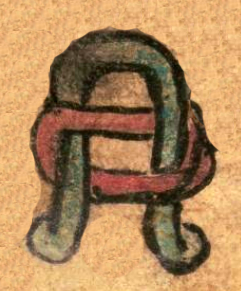xihuitl (CQ)
This simplex glyph is the sign for the solar year in Mixtec codices. In Nahuatl it translates as (xihuitl). It is called the A-O sign, because one part looks like the letter A (with curling feet but no crossbar). The other part is a horizontal letter O, which is entwined with the A. Here, the A is a turquoise blue, and the O is red.
Stephanie Wood
Turquoise blue is a color that sometimes has an association with the word year (xihuitl)] in Nahuatl. The Codex Quetzalecatzin also has year symbols that look like eggs and some like circles, as shown in this collection. Elizabeth Hill Boone states that the A-O sign was usually employed to distinguish a year date from day signs. [See her book, Cycles of Time and Meaning in the Mexican Books of Fate (2017, 218).] The A-O sign, according to Maarten Jansen had the same reading for Nahuas as Mixtecs, but sometimes Nahuas added leaves to the sign, to call forth (in yet another way) the term xihuitl, given that this same word also had the meaning of herbs and green things. [See Maarten Jansen and Gabina Aurora Pérez Jiménez, Time and the Ancestors: Aztec and Mixtec Ritual Art (2017, 417).]
Stephanie Wood
covers ruling men and women of Tecamachalco through 1593
Stephanie Wood
years, años, time, tiempo, dates, fetchas, xiuhpohualli, turquesa, xihuitl

xihui(tl), year, https://nahuatl.wired-humanities.org/content/xihuitl
el año, un año
The Codex Quetzalecatzin, aka Mapa de Ecatepec-Huitziltepec, Codex Ehecatepec-Huitziltepec, or Charles Ratton Codex. Library of Congress. https://www.loc.gov/item/2017590521/
The Library of Congress, current custodian of this pictorial Mexican manuscript, hosts a digital version online. It is not copyright protected.






